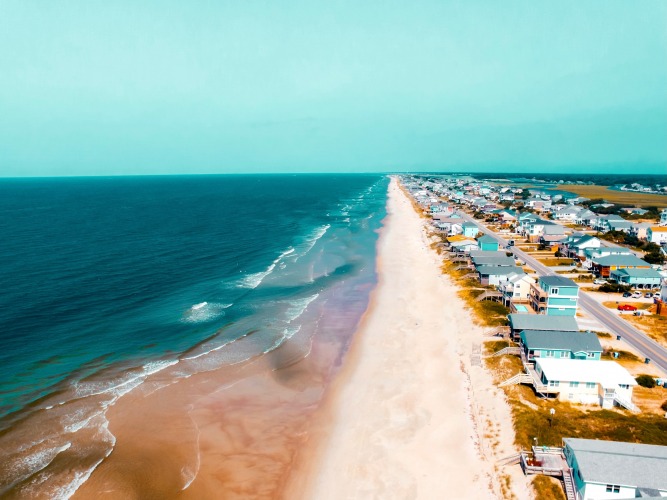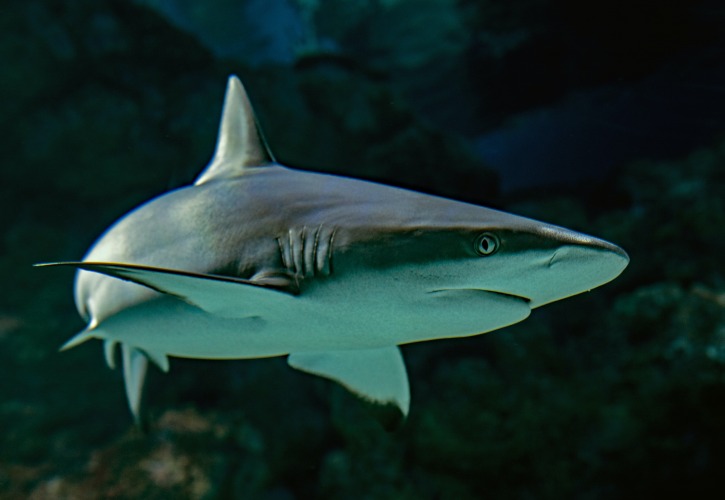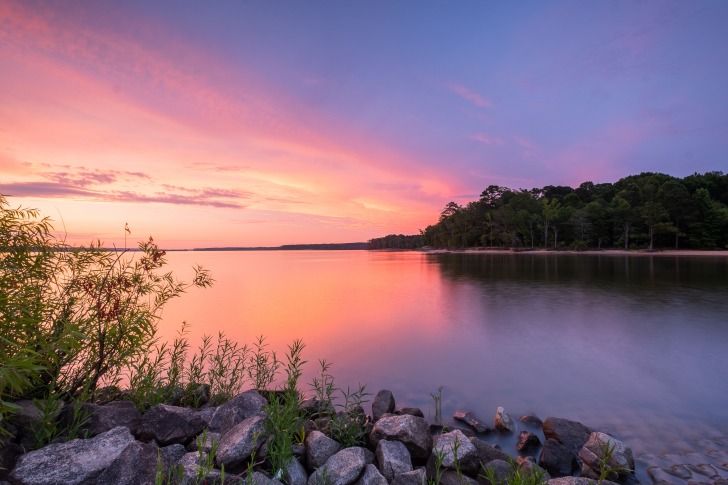North Carolina is not the first place I would think of when I think of sharks.
What about the sharks in NC?
Are there any?
Contents
So… Are There Sharks in North Carolina?
Indeed, North Carolina has sharks.
If looking for them, you’ll usually find them where the rivers meet the ocean and in the sea.
They also spend time in inlets containing large islands near them.
The inlet-island water areas are typically referred to as “sounds.”
Sometimes, sharks just pass through fresh or brackish (a combination of salty and fresh) waters looking for food.
Other times, they’re residing in “the sounds” for the long term, nursing their young for several months.

Some sharks swim up to 50 miles in a day.
Speeds range from about 1.5 miles to about 25 miles per hour, depending on the species.
You never know which of the dozens or even hundreds of sharks from the ocean may make their way to NC.
This list makes up the most common shark species in North Carolina though.
They may come inland but spend much of their time on the East Coast of the Atlantic Ocean.
Otherwise, they hang out in NC sounds.
Great White
The Great White shark can grow to at least 20-21 feet long.
It may stay in North Carolina any time of the year, but it seems to appear here in the winter and early spring the most.
NC sharks usually stay close to the coast but typically offshore enough away from the beaches.
It depends though.
They may sometimes show up right near the beach shore.
I found it fascinating that unlike most animals the female Great White is often longer than the male.
The female grows to about 15-16 inches, and the male extends to about 13-15 feet.
Bull
Bull sharks are one of few that can tolerate both fresh and salty water, so you probably will see them in brackish conditions.
That’s where the water contains almost as much salt as the ocean but still has fresh water mixed in it.
You may see bull sharks in the Albemarle Sound area.
They also frequent the Pamlico, Newport, and Neuse Rivers.
They’re one of the most aggressive sharks that exist, and they have even reportedly attacked prey that is larger than them, such as dolphins.
Bull sharks remain one of the most dangerous to humans.
It’s mostly because of people overcrowding their habitat and defense against hunting for provoked and unprovoked attacks.
They usually grow to at least 7-11.5 feet and might weigh 200-500 pounds.
Females often grow longer than males, which always surprises me concerning my previous experience studying animals.
Sandbar
Sandbar sharks often grow up near Cape Hatteras by Delaware and Chesapeake Bays.
As they become juveniles, you might see them in the Pamlico Sound area.
They grow to about 8 feet long and can weigh about 100-200 pounds.
Sandbars most often show up in NC waters in the summer and autumn.
However, you can see them occasionally strolling around here year-round.
Their population has declined because of hunting, but they’re slowly being replenished.
Tiger
Like the bull shark, the tiger shark (Galeocerdo cuvier) is one of the most dangerous in the NC area.
It doesn’t seem to have a picky diet, and it is even known to dig through trash looking for food.
The tiger shark typically eats bony fish and sharks, dolphins, sea turtles, squid and octopi, rays, shellfish and lobsters, and marine birds, among other animals.
You’ll find tiger sharks near the Beaufort inlet.
They grow to about 18 feet, with an average of 10-14 feet.
They weigh 850-1400 pounds.
Sand Tiger
Sand tiger sharks grow up to 12 feet.
For some reason, they like to hang around wreck sites and prefer to stay close to the ocean floor.
They do, however, come up to the water surface for air and hold it in while sitting still and looking for prey underwater.
I didn’t like what I learned about the sand tiger, but every creature is different.
Some sand tiger sharks will eat their siblings in the womb but leave two until they are four feet long.
In spite of this, they do spend quite a bit of time around diving sites and in aquariums.
Sand Tiger sharks don’t have the same aggression towards humans that they do each other.
I think that’s why they’re tourist attractions.
They seem to treat their own kind harsher than they ever would “us.”
Scalloped Hammerheads
Scalloped Hammerheads remains one of the most popular large hammerhead species in North Carolina.
However, they also suffered a drastic population decline because of hunting.
At least 75% of its original population has dissipated.
Stricter fishing quotas have made it possible to avoid total scalloped hammerhead extinction.
They grow to about 6-8 feet long and weigh about 64-80 pounds, but they can grow to as long as 14 feet.
Spinner
So-called because of the water spins it makes, the spinner shark has a close relationship to blacktip sharks.
They extend to about 10 feet long, averaging about 6-9 feet.
Typical weights are 120-200 pounds.
Spinner sharks typically spend their time in the ocean.
They frequently show up in North Carolina in the Atlantic to the northern portion of the Gulf of Mexico.
Dusky
At birth, they’re already four feet long.
They grow to about 12-14 feet, and they take 17 years to become an adult and can weigh approximately 765 pounds.
Not only are they in the Atlantic near NC, but they also swim as far north as Massachusetts and as far south as Brazil, Cuba, and the Bahamas.
Thresher
The thresher shark may come slower to the shore than other North Carolina sharks.
It’s possible to see them from the beach in early spring and winter. Some spots you might notice include Cape Lookout and Cape Hatteras.
Adult thresher sharks may reach 15-20 feet.
The young ones may grow to about 4.5-6 feet long.
They can put on as many as about 1,100 pounds.
Atlantic Sharpnose
You may notice Atlantic Sharpnose sharks in both the ocean and its estuaries.
The best time to see them is in the summer and fall.
Their newborns are much shorter than other species, growing to only a foot long instead of perhaps four feet long like the threshers.
I highly doubt this shark could do much damage to a human even if it wanted to.
The Atlantic Sharpnose doesn’t prefer people as food, and it’s only about 7-9 pounds and only grows to a maximum of 4 feet.
Bonnethead
Bonnethead sharks typically can only reach up to 5 feet, so they’re not the longest of the NC bunch.
Common places to see them include the Core Sound South and Pamlico Sound.
They might congregate near the barrier islands by the ocean too.
Bonnetheads typically only weigh up to about 24 pounds and grow only an average of 2 feet long.
Like some other shark species, males are shorter than females, which is always an amazement to me.
That’s one feature that sets them apart from other creatures.
Blacktip
Blacktip sharks in the North Carolina sounds are among the longest of their species.
They grow to about 8 feet, but most of them reach an average of 6 feet.
They weigh 66-200 pounds.
Blacktips typically show up in ocean waters most in late fall and late spring.
When they’re not here, they’re in the sounds.
I have noticed a pattern with most of the NC shark species, and any other place in the world for that matter.
They migrate like birds, so to speak, to enjoy ideal weather and feeding conditions.
Smoothhound
Smoothhound sharks typically are born in the Pamlico, Core, and Back Sounds.
As they grow up, the juvenile ones seem to stay near the shore and/or shallow waters.
Their proximity to the beach is probably why fishers catch them, but it’s also a place to view them.
Smoothhounds grow to about 5 feet and may weigh about 29 pounds.
They’re not the largest or the longest in NC by any means.
Blacknose
Blacknose sharks average lengths of 4-6 feet long.
They weigh about 22 pounds, depending on how large they have grown.
Blacknose sharks typically hang out in southern Cape Hatteras, and people most often see them here in the summer.
Sometimes, they wander into the inlets.

Is it Safe to Swim in North Carolina?
In designated areas, it’s safe to swim in North Carolina.
Some places you may want to try to include Sennett’s Hole in Durham, Buddle Creek in Lexington, Butts Your Butt Falls in the Highlands, and Lake James State Park in Nebo.
Pay attention to swimming notices though.
For instance, you might see water quality reports that say that you should NOT swim on a certain beach at least temporarily.
Otherwise, maybe winds and storms might not permit it.
One thing you can be sure of, sharks are probably one of the least worries you’d have.
Only about three species of sharks in the entire world are moderately to severely dangerous to humans.
Even then, they’re not typically near the shore often enough to cause problems.
Interesting Shark Facts in North Carolina
I found it fascinating that of all the sharks I found in NC not many of them pose a threat to humans at all.
That’s a common misconception.
This doesn’t mean they won’t ever attack a person, but the chance that they’re looking for humans to eat is almost zero.
I also found it amazing that most of the time, sharks apparently ignore humans.
Many people who frequent the oceans and other NC waters may have been around one and didn’t know it.
Bull sharks can handle a lower percentage of salt in their water than other types of sharks.
That’s why you would see them inland instead of at the ocean for longer periods.
Either way, most sharks prefer water temperatures from 60-80 degrees F.
The longest they can usually tolerate freshwater is about two to three days.
3 Safety Tips for Swimming in Shark-infested Waters
1. Prepare for an emergency.
If you have at least one person with you, someone can be on the lookout and call for help.
If you have a group of three to four people, someone can stay near the shore while you swim or boat further away.
Those are just some of the ways you can prepare for any water emergency, including a shark sighting.
Wear life jackets when boating too.
2. Don’t swim when it’s dark.
Sharks typically hunt for prey the most in the early morning and early evening.
Swim in the daylight to prevent them from accidentally thinking you’re another animal.
They don’t see well in the dark.
3. Leave quietly if you see one.
This isn’t a filming of one of the Jaws movies.
Try not to make a scene when you leave the water if you see a shark.
That may only make the situation worse because it could startle the shark.
Then, it may attack.
Summary
You will probably see sharks in North Carolina.
Most of them don’t want to be bothered by humans though, but they don’t seem to mind people watching them from a distance.
North Carolina Safety Overview
READ THE FULL REPORT: North Carolina Safety Review
Safety Index:
- OVERALL RISK: MEDIUM
- TRANSPORT & TAXIS RISK: LOW
- PICKPOCKETS RISK: LOW
- NATURAL DISASTERS RISK: HIGH
- MUGGING RISK: MEDIUM
- TERRORISM RISK: LOW
- SCAMS RISK: MEDIUM
- WOMEN TRAVELERS RISK: LOW
Frequently Asked Questions
What are the reasons sharks travel in North Carolina?
They might be looking for a spot to mate or nurse.
Otherwise, they’re looking for food or for either cooler or warmer water.
Where can children see sharks in North Carolina?
I get it.
Everyone is fascinated by animals they don’t see every day.
The safest way to see sharks with children is at an indoor aquarium.
Pine Knoll Shores, Cape Fear Shoals, and the Fort Fisher aquarium are examples of some places you can go with your kids.
Do people die from NC shark attacks?
It’s unfortunate that some people have died from NC shark attacks.
However, it’s rare. Only 14 fatalities occurred between 1900 and 2021.












Sharks are indeed a part of North Carolina’s diverse marine life, often found where rivers meet the ocean and in “the sounds” near large islands; while they may seem intimidating, most species pose little threat to humans.